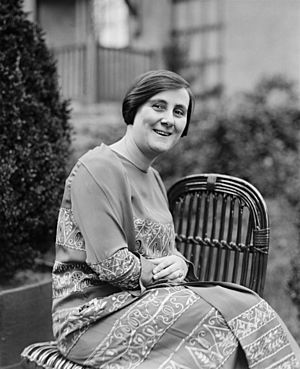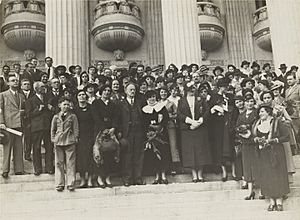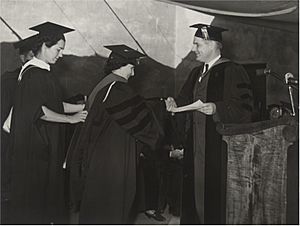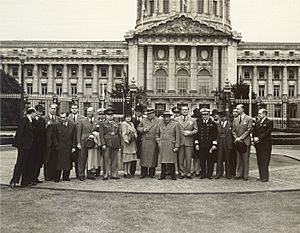Bertha Lutz facts for kids
Quick facts for kids
Bertha Lutz
|
|
|---|---|

Bertha Lutz in 1925
|
|
| Born |
Bertha Maria Júlia Lutz
August 2, 1894 |
| Died | September 16, 1976 (aged 82) Rio de Janeiro, RJ, Brazil
|
| Nationality | Brazilian |
| Other names | Lutz Berta |
| Occupation | Brazilian scientist |
Bertha Maria Júlia Lutz (August 2, 1894 – September 16, 1976) was a remarkable Brazilian zoologist, politician, and diplomat. She became a leading figure in the Pan American women's rights movement and the human rights movement. Bertha Lutz was very important in helping women gain the right to vote in Brazil. She also represented her country at the United Nations Conference on International Organization. There, she signed her name to the United Nations Charter, a very important document. Besides her political work, she was a naturalist at the National Museum of Brazil, where she studied poison dart frogs. Four frog species and two lizard species are named after her.
Contents
Early Life and Education
Bertha Lutz was born on August 2, 1894, in São Paulo, Brazil. Her mother was British, and her father was Swiss-Brazilian. Her father, Adolfo Lutz (1855–1940), was a famous doctor and scientist. Her mother, Amy Marie Gertrude Fowler, was a British nurse.
As a teenager, Bertha became very interested in women's rights. She studied natural sciences, biology, and zoology at the University of Paris – Sorbonne. She graduated in 1918. Soon after getting her degrees, she returned to Brazil. Later, she studied law at the Federal University of Rio de Janeiro, graduating in 1933. While she was in Europe, she was also inspired by the strong movement for women's voting rights.
Career Highlights
Fighting for Women's Rights
Bertha Lutz came back to Brazil in 1918. She joined the Legiao da Mulher Brasilera (Brazilian Women's Legion). This group aimed to provide social services for women in Brazil. In 1920, Bertha helped start a new group called the Liga para a Emancipação Intelectual da Mulher (The League for Intellectual Emancipation of Women). This group wanted women to be included in scientific fields.
In 1922, Lutz created the Federação Brasileira pelo Progresso Feminino (the Brazilian Federation for the Advancement of Women, FBPF). This organization brought together women from all over Brazil. It focused on social and economic issues affecting women. Later, the FBPF also started to fight for women's right to vote. Within a year, Lutz and other members organized an international meeting in Brazil. Important feminists like Carrie Chapman Catt attended this event.
Leading the Vote for Women
The FBPF began to push for women's voting rights across the American states. Bertha Lutz was a big part of these campaigns. She went to the Pan-American Conference of Women in Baltimore, Maryland in 1922. She kept attending women's rights conferences in the following years. In 1925, she was chosen as president of the Inter-American Union of Women.
Bertha Lutz became the main leader for women's rights in Brazil. This continued until the end of 1931. That's when Brazilian women finally won the right to vote!
Continuing the Fight for Equality
Even after women gained the right to vote, Bertha Lutz kept fighting for their rights. In 1933, she got her law degree. Then, at the Inter-American Conference in Montevideo, Uruguay, she suggested new ideas for equal rights for men and women. She especially wanted the Inter-American Commission of Women to focus on fair treatment for women in the workplace.
In 1935, Lutz ran for a seat in the National Congress of Brazil. She came in second place. A year later, she took the place of the person who won, becoming one of the few Brazilian Congresswomen at that time. Her first idea in Congress was to create a "Statute of Women." This committee would check every Brazilian law to make sure it didn't violate women's rights.
However, Getúlio Vargas became dictator again in 1937. This stopped parliament, and Bertha's "Statute" project couldn't move forward. Still, Lutz continued her work as a diplomat. In 1945, she was one of only four women to sign the United Nations Charter. This happened at the Inter-American Conference of Women in San Francisco. She also served as vice president of the Inter-American Commission of Women from 1953 to 1959.
Important Conferences
At the 1922 Pan-American Conference of Women, Lutz spoke strongly for equal rights and chances for women. She especially wanted women to be included in politics.
At the 1933 Inter-American Conference of Montevideo, Lutz brought a study about the legal status of women in the Americas. She argued that a married woman's nationality should not depend on her husband's. She also suggested an Equal Rights Treaty. She pushed the Inter-American Commission of Women to focus on the working conditions of women.
During the 1945 United Nations Conference on International Organization in San Francisco, Lutz and Minerva Bernardino fought hard. They wanted the word "women" to be included in the preamble of the United Nations Charter. The first draft didn't mention women. Against the wishes of some other delegates, Lutz and other women from Latin America insisted. The final part of the Charter now reads: "...faith in fundamental human rights, in the dignity of the human person, in the equal rights of men and women and of nations large and small."
She also suggested that the UN create a special group. This group would study the "legal status of women" worldwide. This would help them understand the inequalities women faced and fight against them. Bertha Lutz is known as the most determined person to include women's rights in the UN Charter. Without her work, the United Nations might not have a clear goal to protect women's rights.
In 1964, Lutz led the Brazilian group at the 14th Inter-American Commission in Montevideo. In 1970, at the 15th annual meeting of the Inter-American Commission of Women, she suggested a workshop. This workshop would focus on problems faced by indigenous women. Even in her seventies, Lutz kept going to conferences. She continued to push for more rights for women. This included attending the World Conference on Women, 1975, in Mexico City.
Scientific Discoveries
After returning to Brazil in 1918, Bertha Lutz focused on studying amphibians. She was especially interested in poison dart frogs and frogs from the Hylidae family. In 1919, she started working at the Museu Nacional do Rio de Janeiro. She later became a naturalist in the Botany section.
Throughout her life, Lutz published many scientific studies. Some of her most famous works include “Observations on the life history of the Brazilian Frog” (1943) and “A notable frog chorus in Brazil” (1946). In 1958, she described a frog now called Lutz's rapids frog (Paratelmatobius lutzii). It was named in honor of her father.
Bertha Lutz is also honored in the names of two Brazilian lizard species: Liolaemus lutzae and Phyllopezus lutzae. Four frog species are also named after her: Pristimantis lutzae, Dendropsophus berthalutzae, Megaelosia lutzae, and Scinax berthae.
Sadly, many of Bertha Lutz's collections at the Museu Nacional in Rio de Janeiro were destroyed. This happened in a fire that damaged most of the Museum's collections in September 2018.
Selected Works
- “Observations on the life history of the Brazilian Frog” (1943)
- “A notable frog chorus in Brazil” (1946)
- “New frogs from Itatiaia mountain” (1952)
Death
Bertha Lutz passed away in 1976 when she was 82 years old.
See also
 In Spanish: Berta Lutz para niños
In Spanish: Berta Lutz para niños





